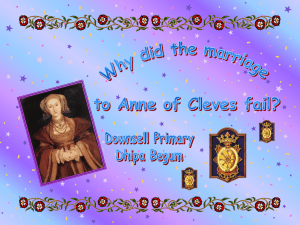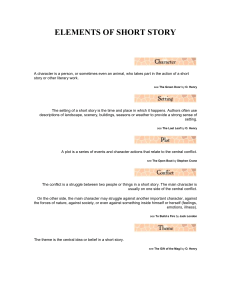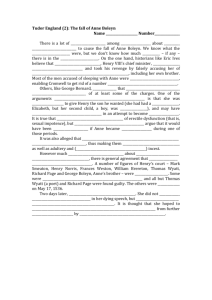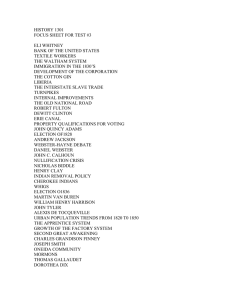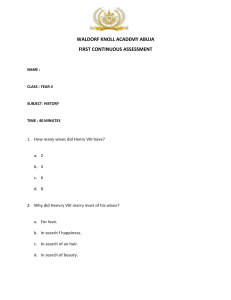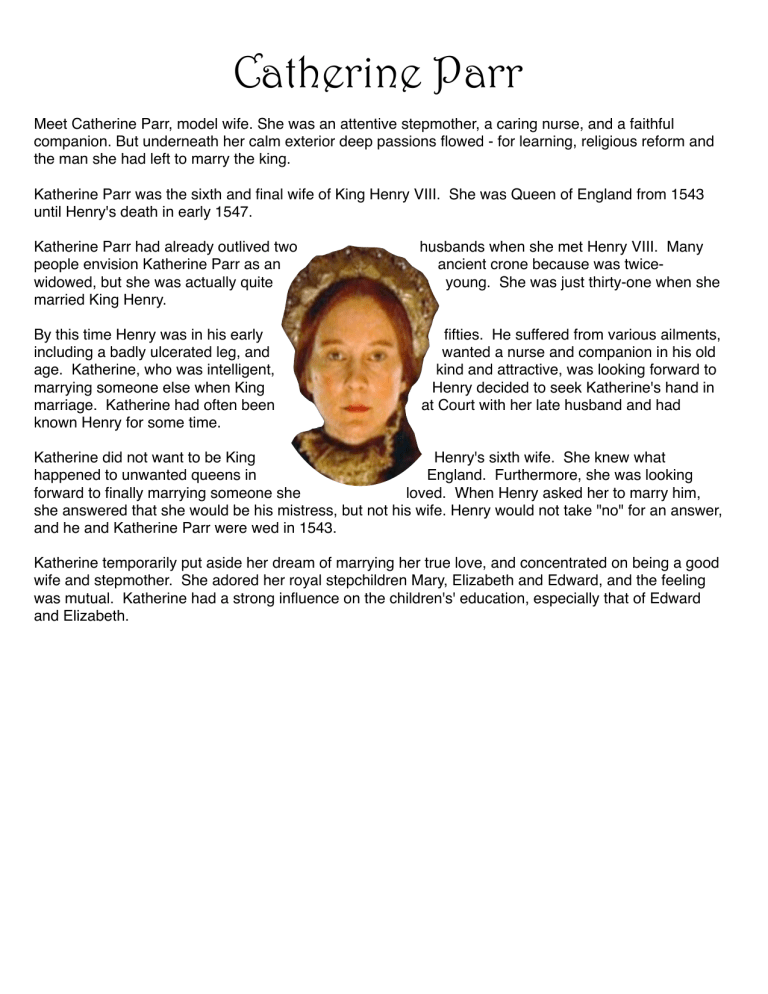
Catherine Parr Meet Catherine Parr, model wife. She was an attentive stepmother, a caring nurse, and a faithful companion. But underneath her calm exterior deep passions flowed - for learning, religious reform and the man she had left to marry the king. Katherine Parr was the sixth and final wife of King Henry VIII. She was Queen of England from 1543 until Henry's death in early 1547. Katherine Parr had already outlived two people envision Katherine Parr as an widowed, but she was actually quite married King Henry. husbands when she met Henry VIII. Many ancient crone because was twiceyoung. She was just thirty-one when she By this time Henry was in his early including a badly ulcerated leg, and age. Katherine, who was intelligent, marrying someone else when King marriage. Katherine had often been known Henry for some time. fifties. He suffered from various ailments, wanted a nurse and companion in his old kind and attractive, was looking forward to Henry decided to seek Katherine's hand in at Court with her late husband and had Katherine did not want to be King Henry's sixth wife. She knew what happened to unwanted queens in England. Furthermore, she was looking forward to finally marrying someone she loved. When Henry asked her to marry him, she answered that she would be his mistress, but not his wife. Henry would not take "no" for an answer, and he and Katherine Parr were wed in 1543. Katherine temporarily put aside her dream of marrying her true love, and concentrated on being a good wife and stepmother. She adored her royal stepchildren Mary, Elizabeth and Edward, and the feeling was mutual. Katherine had a strong influence on the children's' education, especially that of Edward and Elizabeth. Katherine Howard Katherine Howard was the fifth wife of Henry VIII. Her story is short and tragic. She was Queen for only eighteen months before her life ended at a very early age. Katherine Howard was in her teens when she married King Henry who was 49. He was enchanted with the pretty, good-natured young girl, and lavished love and gifts upon her. Henry thought of her as pure and innocent, which her family assured Henry she was when they brought her to Henry's notice. Unfortunately for all concerned, Katherine was not so innocent. She had love affairs in her early teens with two men, and had even promised to marry one of them. Katherine was also not noted for her good sense. Not long into her marriage, she began an affair with Thomas Culpeper, a member of the King's household. This was a very dangerous course of action, and amounted to High Treason. She also made the foolish move of appointing one of her former lovers, Frances Derham, as her private secretary! Within a year of Katherine's marriage, the Archbishop of Canterbury learned of Katherine's past relationships, and King Henry was told the truth about his bride. Henry was devastated, as predicted, and a full-scale investigation of the Queen's activities was launched. It came to light that not only did Katherine have lovers before marrying the King, but during the marriage as well. Katherine, Culpeper and Derham were arrested, along with others who knew about her love affairs. The King refused to see Katherine and allow her to plead her case. Various attempts were made to get her to confess to a formal betrothal to Derham, which would have allowed Henry to have the marriage annulled. This could have saved her life, but, for some reason, she denied any formal betrothal. She also denied committing adultery with Culpeper. In January of 1542, she was found guilty of High Treason, and sent to the chopping block to be beheaded along with two of her lovers. She was not more than twenty years old. Anne of Cleves Anne of Cleves was Henry's fourth wife. She was a member of the German royal house of Cleves, and married Henry for political reasons. The marriage, which took place in the year 1540, lasted for only a few months. Anne was a moderately attractive German princess in her mid-twenties when she came to England. She was reportedly kind, generous and intelligent. She was not, however, musically or artistically gifted, or highly educated beyond the domestic arts. King Henry chose to marry Anne of Cleves sight unseen. He did see her portrait, which he liked. When Anne arrived in England, Henry thought she was plain looking “with skin that sagged”, saying “I like her not!” repeatedly. For reasons of state, he went ahead with the marriage, but was soon looking for a way out of the union when he realized that she spoke no English at all. This was tricky, as Henry did not want to alienate the German states. Anne, however, was agreeable to a divorce. She wasn't particularly thrilled with the marriage herself. Henry was delighted that Anne was so agreeable in this matter. To show his appreciation, and to keep the German alliance in place, he let Anne stay in England, and supported her in grand style. He even made her his honorary "sister". Everyone was happy with the arrangement, and Anne lived a content life on her country estate. Jane Seymour Jane Seymour was Henry VIII's third wife. She was Queen of England for a very short time, from 1536 until 1537. Henry loved her very much for her gentleness, companionship and solid good sense. She gave Henry the son and heir that he had wanted for so long. Sadly, she never had a chance to enjoy her triumph and her baby son. She died of childbed fever shortly after the baby Prince Edward was born. Jane is remembered for being kind, industrious, pious and a good stepmother to Henry's eldest daughter Mary. She most likely would have made a very good queen if she had lived longer. Henry was distraught when Jane died and for months mourned the woman who finally gave him the son he so desperately wanted. For 3 years after her death Henry had his mistresses but refused to marry, despite his advisors wishes. Anne Boleyn Anne Boleyn was the second of Henry's six wives. She was Queen of England from 1533 until 1536. She was one of the first non-royal women to become a Queen of England, which caused quite a stir in those times. She was also the mother of Elizabeth I, one of the greatest monarchs in the history of England and of the world itself. Anne Boleyn was in her early to mid-twenties when she attracted King Henry's attention, in about the year 1525. At the time he noticed Anne, Henry had been married to Catherine for 16 years. Anne was a glamorous, exotic young woman of the minor nobility. She had beautiful dark eyes, long black hair, and a slender figure. She was known for her intelligence, lively personality, and keen wit. She was a skilled musician and dancer, and attracted the attention of many men at Court. Henry courted Anne but she refused him for months and months. Finally in 1532 she relented and soon after became pregnant. They married soon after and she became queen. Disappointment set in for Henry when the baby was a girl--Elizabeth and he started losing interest in Anne. Henry also finally realized how much his marriage to Anne had cost him. A number of good people, including friends and associates of Henry's, had lost their lives due to loyalty and treason issues stemming from the English church's break from Rome. After a final unsuccessful pregnancy, Henry decided he had had enough of Anne. He decided to replace her with Jane Seymour. Because Henry would lose face if he divorced Anne after all he went through to marry her, his advisors conspired some false adultery charges against her. To make the charges look outrageous, Anne was accused of adultery with five different men, including her own brother George. George's wife, the Lady Rochford, testified that her husband had been in intimate contact with Anne. George and Jane's marriage had been arranged, and was not a happy union. Jane Rochford hated both her husband and her sister-in-law, and envied their family closeness. Lady Rochford's words, although lies, carried a lot of weight. Although Anne was truly innocent of all charges, she was found guilty of treason by a court and sent to the chopping block where she was beheaded. Catherine of Aragon Catherine of Aragon was the youngest surviving child of Ferdinand and Isabella of Spain. As was common for princesses of the day, her parents almost immediately began looking for a political match for her. When she was three years old, she was engaged to Arthur, Henry VIII’s brother. Arthur was not even quite two at the time. When she was almost 16, in 1501, Catherine made the journey to England. Catherine and Arthur were married and she was escorted by the groom's younger brother, Henry. Less than six months later, Arthur was dead,. Although this marriage was short, it was very important in the history of England, as will be apparent. Henry VII still had another son, this one much more robust and healthy than his dead older brother. The English king was interested in keeping Catherine in the family, so 14 months after her husband's death, she was betrothed to the future Henry VIII. When Henry VII died in 1509 and one of the new young king's actions was to marry Catherine. She was finally crowned Queen of England in a joint coronation ceremony with her husband Henry VIII on June 24, 1509. Shortly after their marriage, Catherine found herself pregnant. This first child was a stillborn daughter born prematurely in 1510. This disappointment was soon followed by another pregnancy. Prince Henry was born in 1511 and there were great celebrations for the birth of the young prince, but they were halted by the baby's death after 52 days of life. Catherine then had a miscarriage, followed by a short-lived son. On February 1516, she gave birth a daughter named Mary, and this child lived. Henry had at least two mistresses and had begun to separate Catherine because he had fallen in love with one of her ladies sister of one of his mistresses): Anne Boleyn. Catherine was 42 years old and was no longer able to conceive. Henry's main goal now was to get a male heir. At first, Catherine was kept in the dark about Henry's plans for their annulment. When the news got to Catherine, she was very upset. Catherine appealed directly to the Pope, who was against any divorce. Things came to a head in 1533 when Anne Boleyn became pregnant. Henry had to act, and his solution was to reject the power of the Pope in England. Henry then annulled the marriage himself and married Anne Boleyn. from (and
